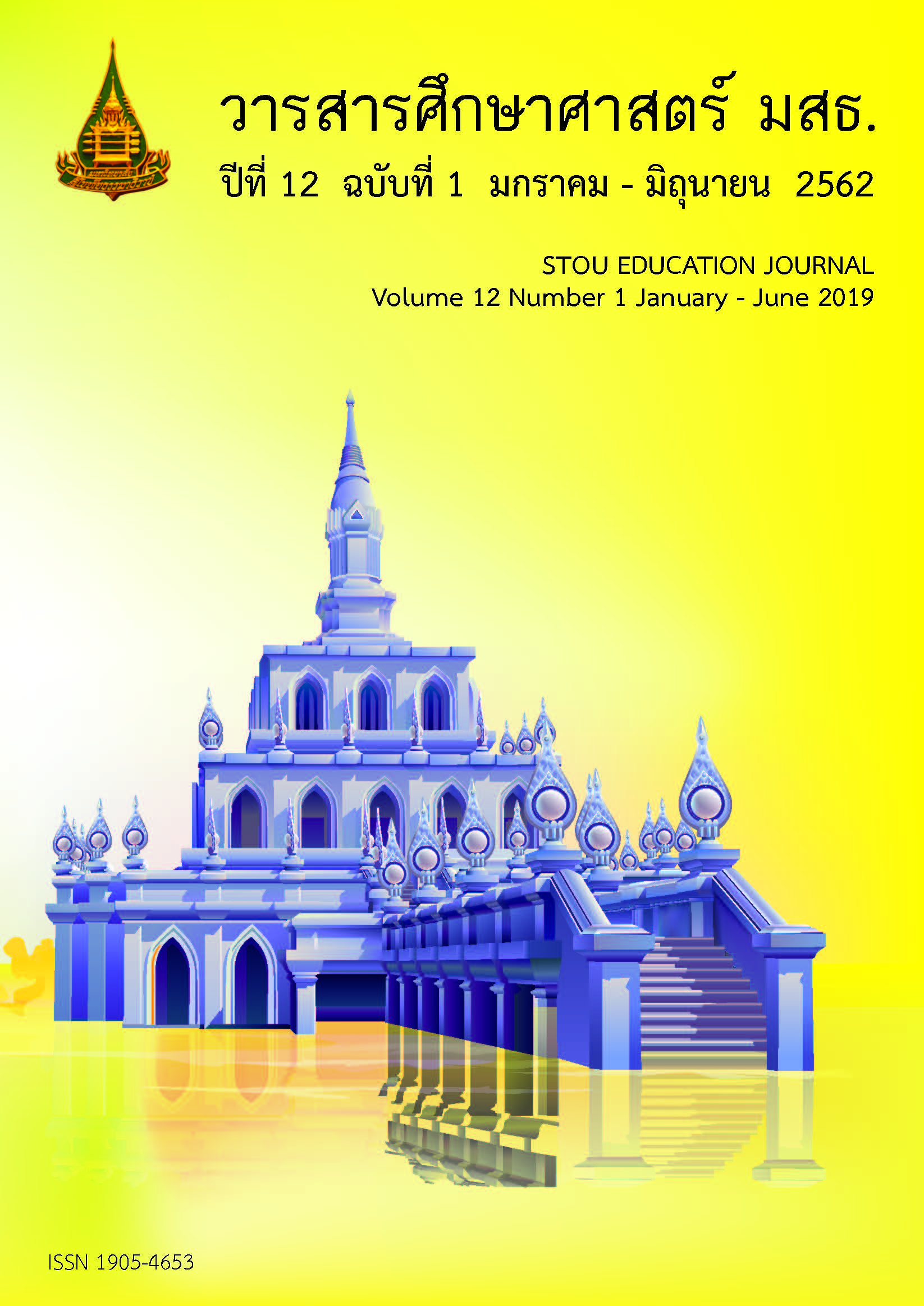Constructivist Online Lesson Model to Enhance Critical Thinking of Upper Secondary Students
Main Article Content
Abstract
This research aimed to 1) create a constructivist online lesson model to enhance critical thinking of upper secondary students; and 2) study implementation results of the constructivist online lesson model to enhance critical thinking of upper secondary students. The sample was 87 students in two classes, two schools under the Secondary Educational Service Area Office 28, Sisaket province, obtained by the cluster random sampling. Instruments used in this research were the constructivist online lesson model to enhance critical thinking of upper secondary students, a critical thinking test form and a learning achievement test form in the topic of electric current. Statistics used in this research were mean, standard deviation, efficiency criterion and t-test. Results were found that 1) the constructivist online lesson model to enhance critical thinking of upper secondary students consisted of six components which were intellectual stimulation, correction wit, intellectual cooperation, critical thinking evaluation, scaffolding, and apprentice. An overall of this model evaluation by experts about design and operation was at a high level; and 2) the implementation result of the created online lesson model was found that (1) the model efficiency was 87.40/89.99 and the repeated experiment was 85.81/82.94, (2) the post-test critical thinking of the students was higher than their pre-test at the significant level of .01, and (3) the post-test learning achievement of the students in the topic of electric current was higher than their pre-test at the significant level of .01.
Article Details
References
กนกรส คำใบ. (2559). การพัฒนารูปแบบการเรียนการสอนผ่านเว็บด้วยโครงงานเพื่อพัฒนาการคิดอย่างมีวิจารณญาณสำหรับนักเรียนระดับมัธยมศึกษา. (ดุษฎีนิพนธ์ปริญญาปรัชญาดุษฎีบัณฑิต ไม่ได้ตีพิมพ์). มหาวิทยาลัยรามคำแหง, กรุงเทพมหานคร.
กัญญาณัฐ เกษมสุข. (2557). ผลของสิ่งแวดล้อมทางการเรียนรู้ตามแนวคอนสตรัคติวิสต์บนแท็บเล็ตที่ส่งเสริมการคิดอย่างมีวิจารณญาณ เรื่อง การปฏิบัติตนตามข้อตกลง กติกา กฎ ระเบียบ หน้าที่ในชีวิตประจำวัน สำหรับนักเรียนชั้นประถมศึกษาปีที่ 2 โรงเรียนบ้านนาดีคุรุราษฎร์บำรุง จ.หนองบัวลำภู. (การค้นคว้าอิสระปริญญาศึกษาศาสตรมหาบัณฑิต ไม่ได้ตีพิมพ์). มหาวิทยาลัยขอนแก่น, ขอนแก่น.
ชัยยงค์ พรหมวงศ์ และวาสนา ทวีกุลทรัพย์. (2540). หน่วยที่ 4 ชุดการสอนรายบุคคล. ใน เอกสารการสอนชุดวิชาสื่อการศึกษาพัฒนสรร หน่วยที่ 1-7. (น.131-132). นนทบุรี: สาขาวิชาศึกษาศาสตร์มหาวิทยาลัยสุโขทัยธรรมาธิราช.
ปรียานุช พิบูลสราวุธ และระวิวรรณ ภคนวัต. (2550). กรอบแนวคิดในการจัดทำร่างหลักสูตรเศรษฐกิจพอเพียง. เอกสารอัดสำเนา.
วชิรพรรณ ทองวิจิตร และจิรพันธ์ ศรีสมพันธุ์. (2555). การพัฒนารูปแบบบทเรียนแสวงรู้บนเว็บวิชาประวัติศาสตร์ท้องถิ่น ชั้นมัธยมศึกษาปีที่ 1 ร่วมกับทฤษฎีสร้างสรรค์ความรู้ผ่านเครือข่ายสังคมออนไลน์. น.95. กรุงเทพมหานคร: การประชุมวิชาการครุศาสตร์อุตสาหกรรมระดับชาติ ครั้งที่ 5 วันที่ 5-6 กรกฎาคม 2555, กรุงเทพฯ, หน้า 439 – 448.
สมศักดิ์ วันสุดล อัจฉรีย์ พิมพิมูล และอมรรัตน์ พันธ์งาม. (2560). องค์ประกอบรูปแบบบทเรียนออนไลน์ตามแนวคอนสตรัคติวิสต์เพื่อเสริมสร้างการคิดอย่างมีวิจารณญาณของนักเรียนระดับมัธยมตอนปลาย. วารสารเทคโนโลยีอุตสาหกรรม มหาวิทยาลัยราชภัฏอุบลราชธานี, 7(1), 135-149.
สุคนธ์ สินธพานนท์. (2551). นวัตกรรมการเรียนการสอนเพื่อพัฒนาคุณภาพเยาวชน. (พิมพ์ครั้งที่ 2). กรุงเทพมหานคร: โรงพิมพ์ 9119 เทคนิคพริ้นติ้ง.
สุดา จันทราช, ทวีศักดิ์ จินดานุรักษ์ และดวงเดือน พินสุวรรณ์ (2559). ผลการจัดการเรียนรู้ตามแนวคอนสตรัคติวิสต์ที่มีต่อการแก้โจทย์ปัญหาและผลสัมฤทธิ์ทางการเรียนวิชาฟิสิกส์ของนักเรียนชั้นมัธยมศึกษาปีที่ 5 โรงเรียนปากช่อง จังหวัดนครราชสีมา. วารสารศึกษาศาสตร์ มสธ., 9 (2), 107-115.


